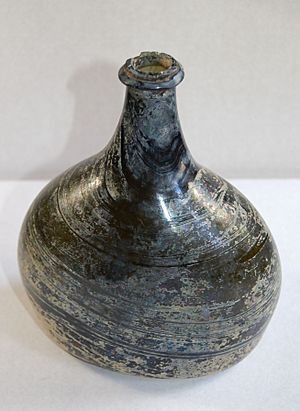Glass onion facts for kids
Have you ever seen an old-fashioned glass bottle that looks like an onion? These special bottles are called onion bottles or glass onions. People used them a long time ago, mostly in the 1600s and 1700s. They were perfect for holding drinks like wine and other spirits.
Contents
Onion Bottles: A Glimpse into Old Glass
The Birth of Stronger Bottles
Imagine a time when glass bottles were thin and broke easily! In the early 1600s, storing and shipping wine was tricky because the bottles weren't very strong. But then, something important happened. Around the 1630s, a clever inventor named Sir Kenelm Digby worked with James Howell. They found a way to make much stronger glass. They used hotter furnaces to create glass that could handle being shipped and stored.
These very first strong bottles were often called "shaft and globe" bottles. They had a tall, thin neck (the shaft) and a round body (the globe).
How the Onion Shape Appeared
Over time, the "shaft and globe" bottles slowly changed their look. By the 1670s, they had become much rounder and flatter, like an onion. This new shape had a wide base and a short neck. It was very popular at the end of the 1600s.
As the 1700s began, the onion bottle shape started to change again. They became a bit taller and less round. This shows how bottle designs kept evolving to meet people's needs.
The Secret Behind Their Color
Have you ever noticed that old bottles are often dark green or brown? Onion bottles got their deep colors from the sand used to make them. This sand contained something called iron oxide, which is a natural mineral.
The color became even darker because of the coal used to heat the furnaces. The intense heat from the coal made the bottles almost black. This dark color was also helpful. It protected the drinks inside from sunlight, which could make them go bad faster.
Why Onion Bottles Were So Useful
Onion bottles were designed to be very practical. They had special rings, called collars, around their necks. These collars helped people tie down the corks tightly. This was important to keep the wine or spirits from leaking out.
When these bottles were shipped, they were often laid on their sides. This helped keep the cork wet. A wet cork stays swollen and tightly sealed, which stops air from getting into the bottle. If air gets in, the wine can spoil, a process called oxidation. Sometimes, people even added strong spirits like brandy to the wine. This helped the wine last even longer, especially during long trips across the ocean.


